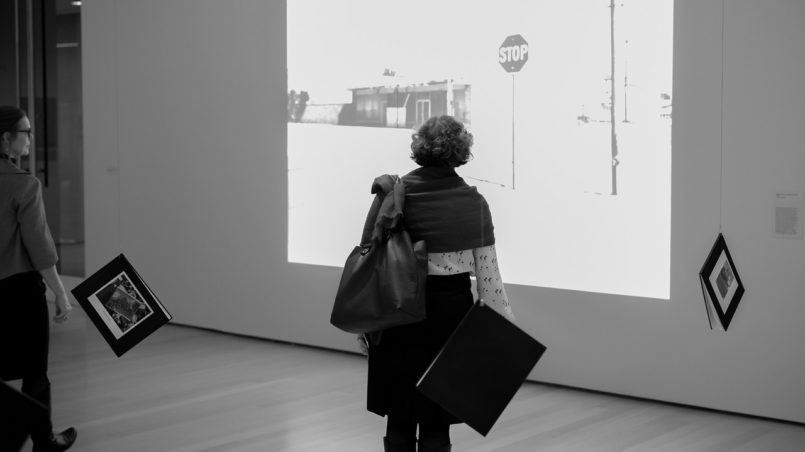Steven Shore hates me.
That’s what I thought as a Bard College freshman in his Photography 101 class, while I argued about why I had not done the assignment as directed: uncropped, unmanipulated, and uncontrived.
Looking back, I have no doubt that he found me annoying and forgettable. Freshman year, I was deeply committed to Dadaism, The Ramones, and my newly acquired black leather jacket. In my spare time, I was reading Man Ray’s autobiography. Steven, also newly arrived at Bard, had a different perspective. “He deliberately oriented the program toward straight photography at a time when most teachers were emphasizing manipulated and constructed photography,” according to a curator’s note at his sweeping MoMA retrospective.
When I ran into him at a recent alumni event Steven, not surprisingly, didn’t remember me.
When I first met him, I had no idea who he was either. I didn’t know that as a 16-years-old, he’d been an unofficial photographer-in-residence at Andy Warhol’s Factory. I had no idea he was the first living photographer to have a solo show at the Metropolitan Museum of Art. And I certainly didn’t know that according to MoMA he was: “One of the most significant photographers of our time…who rose to prominence in the 1970s by capturing the mundane aspects of American popular culture in straightforward, unglamorous images.”
I didn’t even realize that his photographic style would deeply influence what my generation framed and put on our walls as art.
But the thing that would have surprised my 17-year-old self the most was how much Steven would teach me that first year at Bard.
The First Thing I learned from Steven’s class was that I’m not a photographer.
This had nothing to do with whether he liked me or not. It’s a fact. And was confirmed years later during a photojournalism class in grad school. I’m not saying I can’t take a decent snapshot. I can. Steven probably deserves some credit for that skill.
As much as I had fantasized about clicking the shutter and flipping my hair while I crouched for the perfect shot, I was never comfortable behind the lens. I’m completely at a loss when photographers tell me that having a camera makes them feel comfortable in a crowd. Instead of anonymous or purposeful, I feel intrusive obvious, and exposed.
I loved the idea of being a photographer, but I didn’t love the process.
The Second Thing I learned was how to talk about art.
Every week, we’d put our work up on the wall for the class and Steven to critique. I gouged lines into the wooden table with my nails, as it was explained to me that the blown-out areas of my photos were not aesthetic choices or happy accidents, but due to poor exposure.
As uncomfortable as I was in that room, it was where I began learning a vocabulary for visual work. Over the years, I’ve put this vocabulary to good use. Now I write about art, design, and film. Also collaborating with photographers has turned out to be a rewarding part of my career.
The Third Thing I learned was that when you’re truly passionate about something you fight for it.
If in my heart and soul photography was THE thing I loved, I wouldn’t have walked away at the end of freshman year. I would have stayed in that department and fought for my aesthetic or found another college where they were still teaching “manipulated and constructed photography.” Instead, I transferred to the Women’s Studies department. Where I did dig my heels in and fight for my point of view, concluding with my senior thesis, “Women in Bondage: A Social History of Undergarments 1850-1950.”
The Fourth Thing I learned was to set challenges for myself, rather than relying on repeating a successful, comfortable formula.
Years after college when I was writing for a daily, Steven popped into my mind just as I realized that all my articles ended with the same type of pithy quote. During interviews, I’d gotten into the habit of circling that quote, so I knew where I was writing to. It wasn’t a bad formula. It worked. My editor liked it. My readers liked it. But I knew using that formula over and over would never make me a better writer.
Recently, I heard Steven talking about why he’d left the Factory. He only spent a few years hanging out with Any Warhol, Eddie Sedgwick, Lou Reed, and the rest. Most 18-year-old guys would have stuck around. “For a lot of people being at the Factory was going to be the high point of their lives. I didn’t want it to be the high point of mine.”
The Fifth, and most important, Thing I learned from Steven is that just because someone disagrees with you, it doesn’t mean they hate you. It means, they don’t agree with you – and they might be right.
This post is part of the series P.T.A. : Parenting Through the Apocalypse (my occasionally fictional life.)
Photo by Ken Kosakoff


